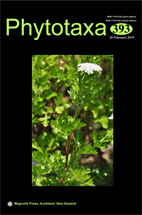Abstract
A new Delicata species, Delicata chongqingensis sp. nov. was found during a survey of freshwater diatoms in the Daning River, Chongqing municipality, China. A detailed morphological description of D. chongqingensis is presented, based on light and scanning electron microscopy. Delicata chongqingensis has dorsiventral, semi-lanceolate valves with a moderately and evenly arched dorsal margin, a straight ventral margin in the central section, and slightly protracted, rounded ends. The central area is a large, irregular semifascia on the dorsal side, bordered by 2–4 shorter central striae. The morphology of the taxon is compared to Delicata sinensis, another species from China with a dorsal semifascia, and other species in the genus. Ecological data including water chemistry and co-occurring diatom taxa are provided for the locations where the new species was found.

